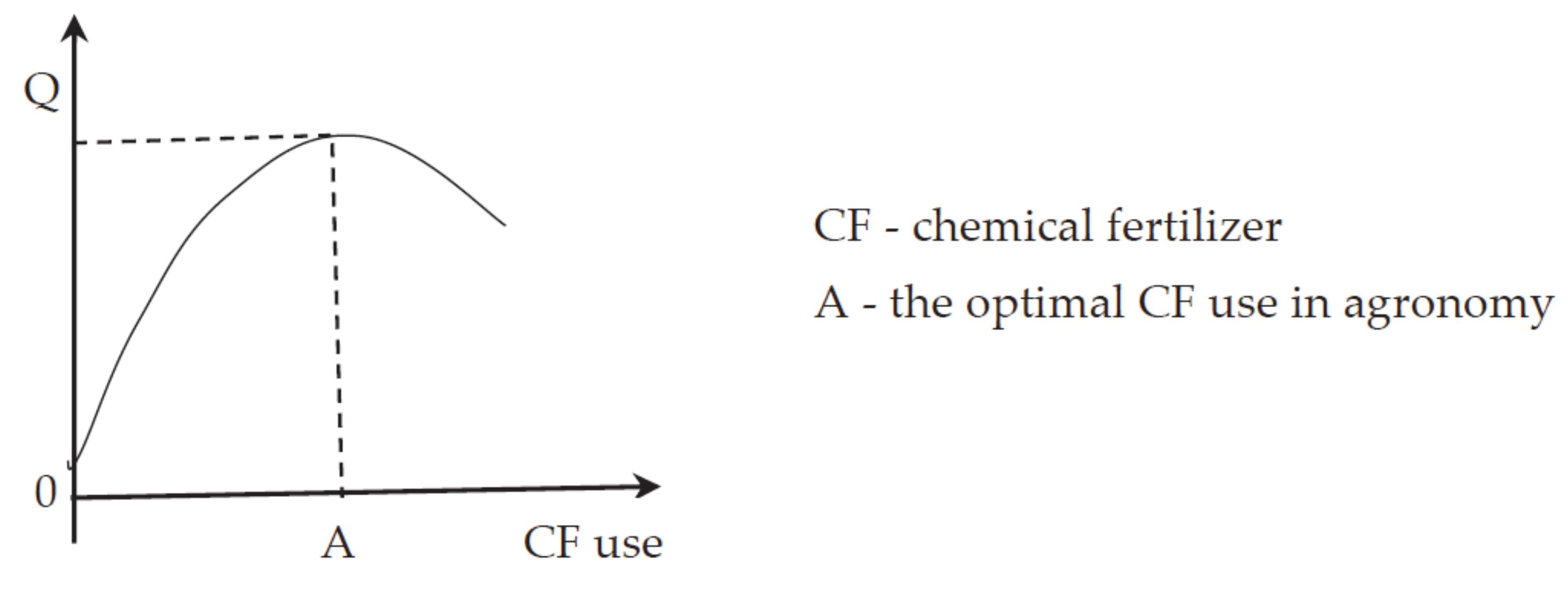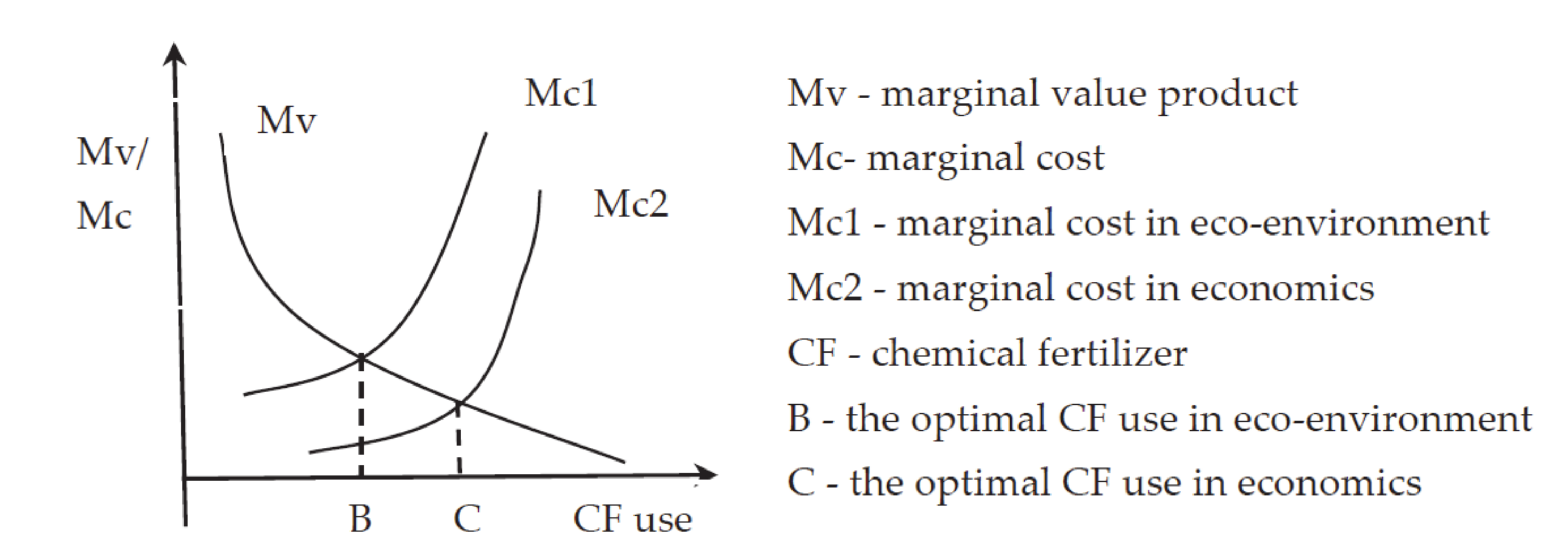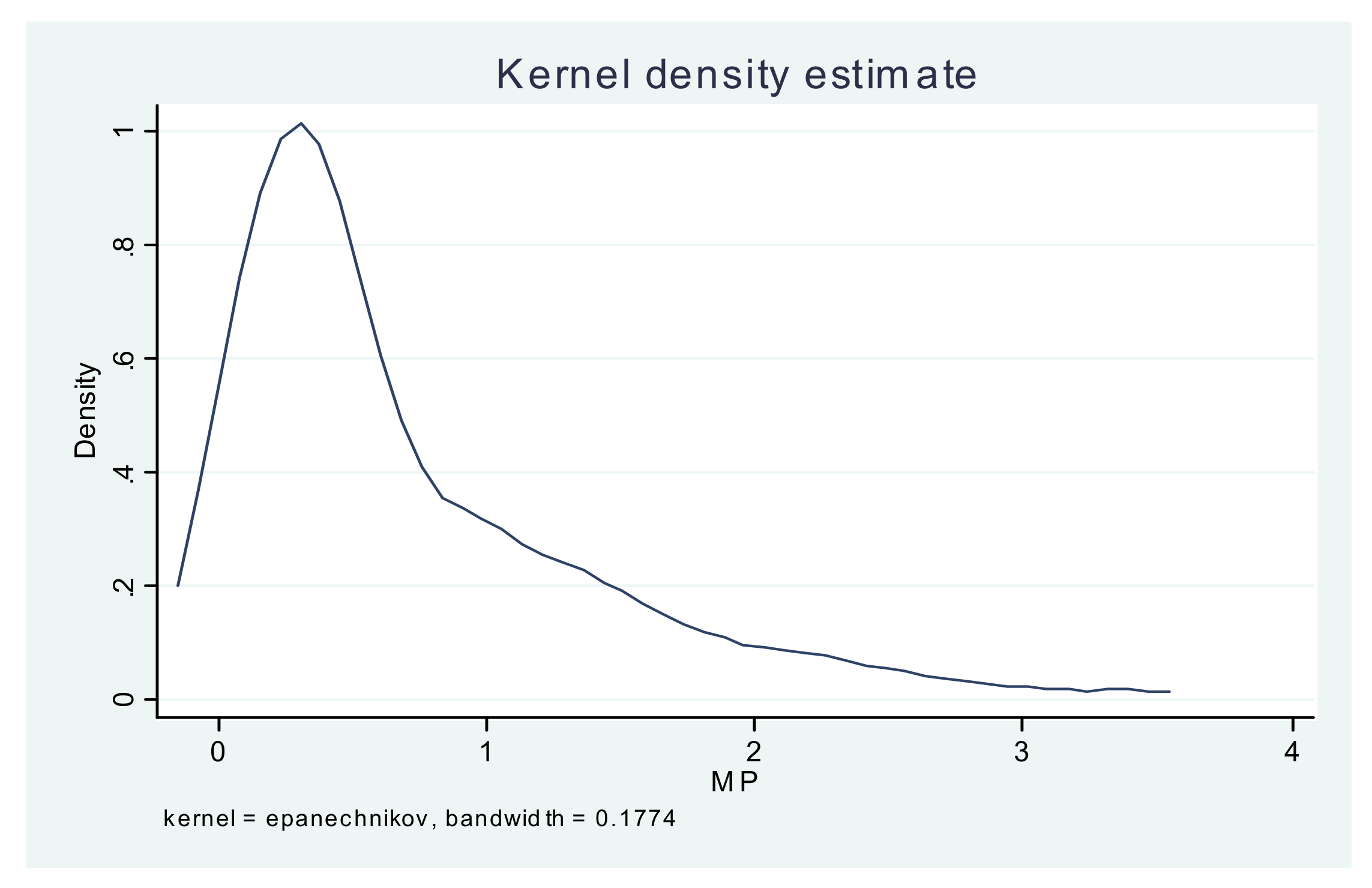1. Introduction
At present, China is the largest consumer of chemical fertilizers (CFs) in the world, accounting for about one-third of the world’s total CF consumption. The amount of CF application per sowing area in China far exceeds the optimal application amount and the global average [
1,
2]. The primary initial purpose of high-intensity CF use in China was to promote agricultural production [
1,
3]. However, such an activity has brought negative effects on the ecological environment, such as eutrophication and water pollution [
4], biodiversity reduction [
5], imbalance of soil nutrients and consolidation of soil [
6]. There is an urgent need to improve fertilization methods and increase the utilization rate of CFs to promote sustainable agricultural development. As a result, the Ministry of Agriculture of China (MAC) decided to initially establish a scientific fertilization management and technology system by 2020, and gradually control the increased rate of CF use within 1% between 2015 and 2019, reaching zero by 2020 [
7].
From 1978 to 2016, the annual application amount of CFs in China increased from 8.84 million tons to 59.84 million tons. The main reasons behind this include the increase in planting area, the adjustment of planting structure and changes in fertilization intensity [
8,
9]. During the same period, the sowing area of China’s grain crops was generally maintained at 11 × 10
7 ha, while its proportion to the total sowing area of crops fell from 80.34% to 67.83%. The planting area of horticultural crops increased from 6.04 × 10
6 ha to 3.81 × 10
7 ha, with an increase from 4.02% to 22.93% in its proportion to the total sowing area of crops [
10,
11]. Some studies have shown that the intensity of CF application for crops is roughly stable over the years, with that for the horticultural crops, such as fruits and vegetables, being the highest [
2,
12]. Although overuse of CFs is common, growers of fruit and vegetable excessively use CFs to a greater extent than growers of grain crops. For example, while the overuse amount of CFs by rice and corn growers are 73–81 kg/ha [
13] and 156 kg/ha [
14], respectively, apple growers overuse an average of 307.5 kg/ha [
15].
Although many studies are concerned about over-fertilization among Chinese households; they are mainly concentrated on the households that grow grain crops, such as maize, wheat and rice [
1,
3,
14,
16,
17]. Some scholars pay attention to the excessive fertilization behavior of horticultural crop growers, such as citrus [
18], peach [
19] and tea [
20]. Some studies have found that the factors influencing households’ over-fertilization include gender, education, risk aversion of the householder [
14,
21], the use of organic fertilizer, participation in training [
17,
22,
23,
24], fertilizer prices [
16], technologies and knowledge of fertilization [
1], non-farm employment and the tendency to accept suggestions from fertilizer sellers [
25]. Schultz [
26] proposed in Transforming Traditional Agriculture that raising smallholder farmers’ skills and knowledge level is one of the main ways to transform traditional agriculture.
Indeed, some scholars have found that the lack of scientific fertilization knowledge and technologies is one of the main reasons leading to over-fertilization from a household’s perspective [
1,
22,
27]. Households lacking agricultural knowledge could hardly distinguish different kinds of CFs, leading to the application of the CFs without knowing the details of the formulas and their specific advantages [
16]. Instead, households tend to rely on their own experience and habits when fertilizing [
15], which include the notions that higher-priced CFs are of better quality [
16] and that the more CFs are applied the higher the yield [
22]. However, it should be noted that the effect of an increase in fertilization has “diminishing marginal benefits” [
28].
In order to guide households to conduct scientific fertilization, the Chinese government has promoted soil testing and formulated fertilization techniques (STFFT), as well as water and fertilizer integration technology (WFIT). Applying STFFT helps households understand the risks of over-fertilization [
29] and guides them to follow an appropriate structure and reasonable intensity of CF application [
3]. Compared to STFFT, WFIT is a relatively new agricultural technology that integrates irrigation and fertilization to meet the crop’s needs for water and nutrients in a timely and appropriate manner. The adoption of WFIT by households is found to have significantly improved the utilization efficiency of CFs [
17,
30].
The Huyi District (formerly known as Hu County) belongs to Xi’an, Shaanxi Province, which is located in the northwestern region of China. It borders with the Qinling Mountains to the south and the Weihe River to the north. This region is rich in light, heat and water resources, which makes grape growing one of the most distinctive and advantageous industries. The Huyi District has a long history of grape planting, with a reputation of being the “Hometown of China’s Hutai Grapes”, as it mainly grows a particular variety, which is Hutai grapes, including Hutai No. 8, Xiahei, Xinghuawang, Sunshine Rose, etc., among which “Hutai No. 8” is the most outstanding and renowned throughout the country. “Hutai No. 8” generally becomes mature in three years and enters the full fruit period in the fourth year, with production of over 30,000 kg per ha. This study chose the growers of “Hutai No. 8” grape in the full fruit period to investigate the effect of fertilization knowledge and technologies on the over-fertilization behavior for two reasons. First, the Huyi District is the original and main planting region of “Hutai No. 8”, which has been cultivated in this region since 1996. The planting area of “Hutai No. 8” reached 64,500 mu (4300 ha, 1 mu = 1/15 ha) by the end of 2015, accounting for more than 90% of the total grape area and about 12% of the total cultivated area in the region [
31]. In addition, there are more than 5000 households whose main sources of income are growing “Hutai No. 8”. Second, “Hu County Grape” was approved as the protection certification of geographical indication products (GIP) by the General Administration of Quality Supervision, Inspection and Quarantine of China in 2012. “Hu County Grape” refers to the grapes grown in the Huyi District. Although there are many varieties, Hutai No. 8 has the largest planting area. As the quality of GIP must comply with certain regulations, the local government guides and standardizes households’ behavior of fertilization through experts giving lectures, field guidance and knowledge training. Therefore, some of these households have a certain knowledge about fertilization and its related technologies, making them appropriate for investigating the issue of interest to this study.
The structure of the paper is as follows:
Section 2 discusses the theoretical foundation of households’ fertilization behavior, followed by the Materials and Methods in
Section 3;
Section 4 presents results of this study;
Section 5 is the discussion; and the last section concludes the study.
5. Discussion
Our findings support the beliefs that households’ over-fertilization is common in grape production in China. This is similar to findings from research in the Zhengjiang province [
61] and Hunan province [
62], but the marginal productivity in this study is much lower than the fertilizer expenditure for grape in these other studies [
61,
62]. The main reason for this is that the climate in the north is drier with less rain than in the south of China, which effects the absorption of nutrients from the CF by crops.
Households’ non-optimal fertilization strategy is a result of the lack of related knowledge and irresponsible fertilizer marketing [
27]. China’s agricultural public service system allows limited household access to accurate fertilization knowledge [
63], which makes it possible for households to be misled by commercial organizations, such as the CF manufacturers and distributors. Technical training organized by fertilizer suppliers are usually focused on promoting CF sales without considering households’ economic benefits or social and environmental costs [
17]. The households’ decisions on CF purchases could be influenced by price and marketing schemes, which can be confusing sometimes as the information about most CF is shown in neither simple nor user-friendly ways [
27]. The diversity of CFs and the market shortcomings make it difficult for households to acquire accurate knowledge on fertilization, leading households to choose rational ignorance [
16]. Especially, local fertilizer distributors usually allow households to purchase fertilizer on credit and pay back after they have sold grapes, which further exacerbates the households’ over-fertilization behavior.
Through field experiments in China, it was proved that advanced crop and nutrient management practices can increase yields with improved CF-use efficiency [
32]. However, the lack of knowledge is one of the main reasons for households’ CF management deficiencies [
27]. The fertilization technique training may enable households to access to knowledge and technologies on scientific fertilization, such as new technology, the amount of fertilizer used, the time for top-dressing, etc. [
21]. The Agricultural Extension Department of China provides a short-term training program on scientific fertilization, which is found to hardly effectively improve the efficiency of fertilizer use [
3] because households’ knowledge gained from a one-time training could slowly wane over time, especially without practicing [
1]. Instead, changing the households’ over-fertilization behavior requires intensive and long-term training [
3] and field guidance [
17,
22], as households need to internalize knowledge and know both how and why [
1]. It is suggested to enable households to achieve the relevant knowledge and technologies by using the Science and Technology Backyard (STB) platform [
27]. STB is an organization whose staff are professors and graduate students from China Agricultural University who live in villages together with peasants for promoting technology transfer to help them increase the return from agricultural production in an environmentally friendly manner.
This study contributes to the literature on households’ over-fertilization behavior. Prior studies focus on the impact of the households’ understanding of the CF’s characteristics [
16] and on training concerning households’ fertilization behavior [
1,
22,
25]. Following the principle of “applying appropriate fertilizers at appropriate times with appropriate methods”, this study examines the effect of fertilizing knowledge and technologies on households’ over-fertilization behavior by measuring the households’ fertilization knowledge and technologies using their experience and knowledge on the timing of the fertilization, the consistency between the fertilizer types and nutrient requirements and the technologies used for fertilization. The results of this study can be used to identify the entry points for reducing the possibility and intensity of excessive use of CFs by households in horticultural crop production, because more training will encourage households to change their fertilization management and protect the local environment [
3]. It is suggested that the Chinese government should promote the establishment of a systematic training program on horticultural crop fertilization and put it into force nationwide. In addition, the government could build a public service platform for information sharing between agricultural experts and households [
61,
64,
65]. On this type of platform, knowledge on crop nutrient management, different types of fertilizers and fertilization technologies can be distributed and on-site advice and reminders can be sent automatically at proper times [
27] to households in an easy–to-understand way based on the farming season and the growth period of the crops. By doing so, one would improve the households’ fertilization knowledge and technologies, which is a win-win measure that could increase households’ income and ensure enhanced environmental sustainability.







